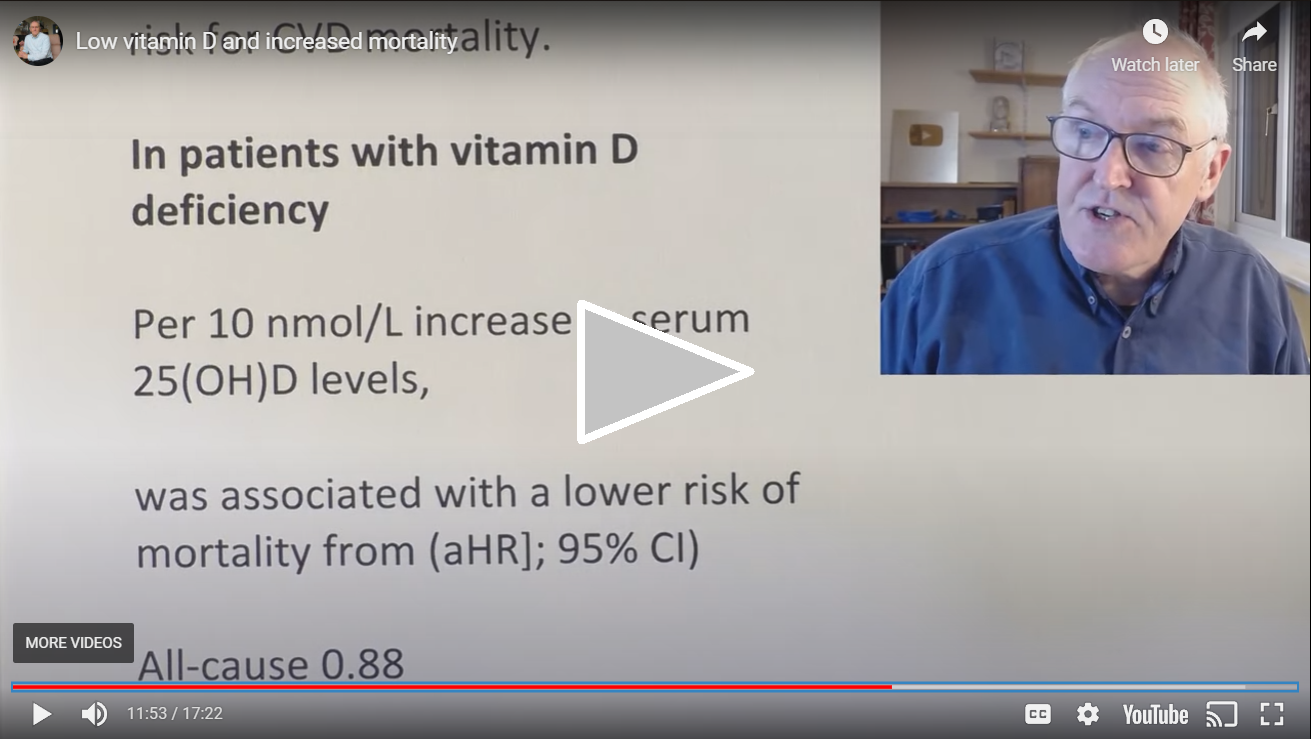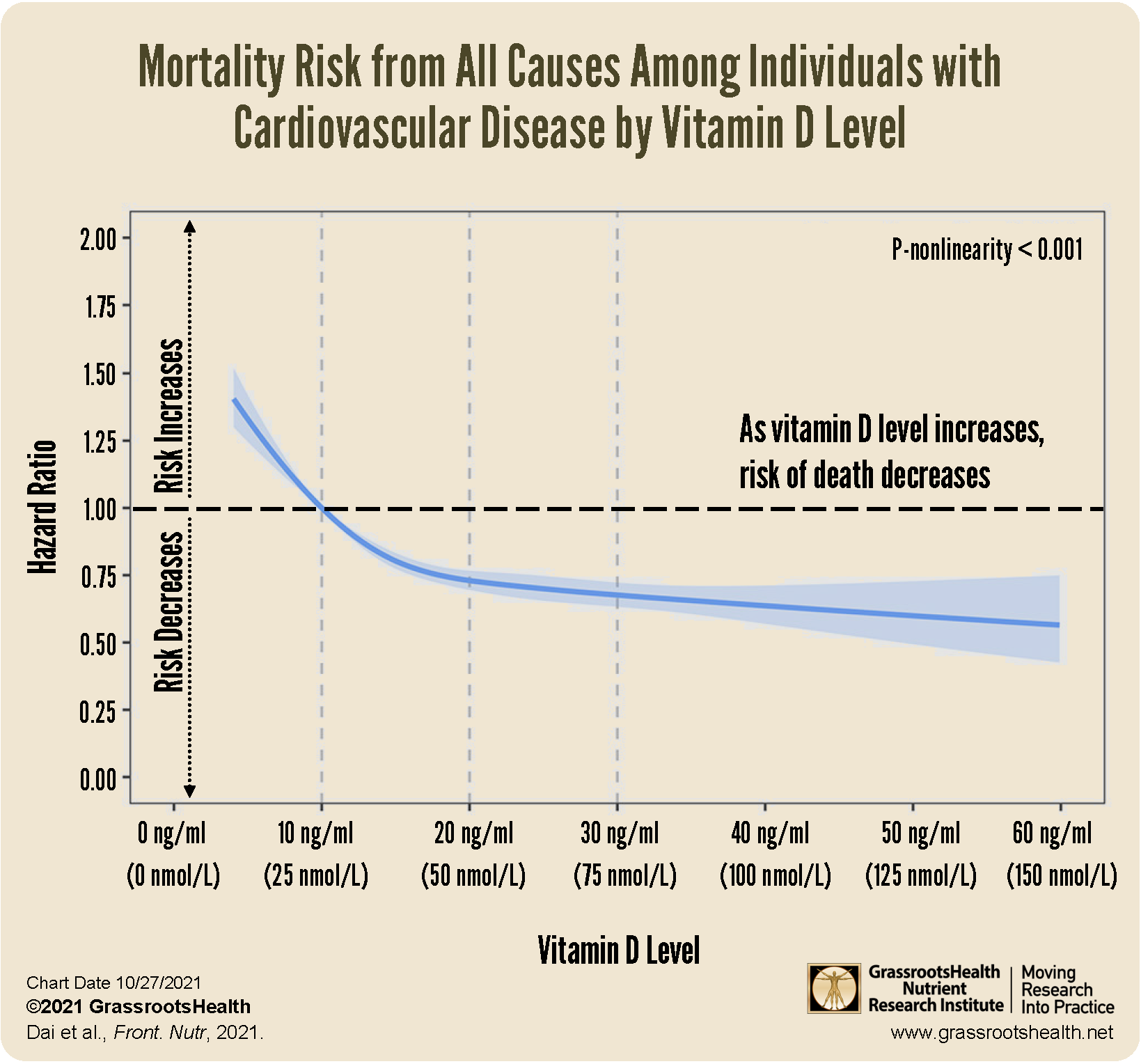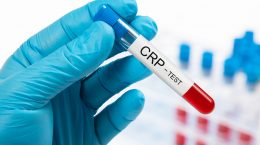Published on October 28, 2021
New study on individuals with cardiovascular disease shows that those with higher levels of vitamin D were less likely to die from all causes over an 11 year follow-up period
Key Points
- A recent study among individuals with cardiovascular disease found that death from all causes (including heart disease, and especially cancer) was significantly associated with vitamin D level
- For every 4 ng/ml (10 nmol/L) increase in vitamin D level was associated with a 12% reduction in risk for all-cause mortality and a 9% reduced risk for CVD mortality
- The effect of vitamin D level on mortality remained even after adjusting for age, sex, alcohol, BMI, glomerular filtration rate (GFR), education, ethnicity, household income, smoking status, healthy diet score, diabetes (and meds), HbA1c, duration of CVD, blood pressure (and meds), lipid profile (and meds), triglycerides, cholesterol
 A new, large-scale observational study by Dai et al., which included data from 37,079 people in the UK with existing cardiovascular disease (CVD), ages 40-69 years, found that death from all causes (including heart disease, and especially cancer) was significantly associated with vitamin D level.
A new, large-scale observational study by Dai et al., which included data from 37,079 people in the UK with existing cardiovascular disease (CVD), ages 40-69 years, found that death from all causes (including heart disease, and especially cancer) was significantly associated with vitamin D level.
Over the study period, there were a total of 6,319 deaths; 2161 deaths from CVD, 2230 deaths from cancer, 623 deaths from respiratory diseases, and 1305 deaths from other causes.
Those starting with vitamin D deficiency (levels less than 20 ng/ml or 50 nmol/L) had the greatest potential for reduced risk of death with increased vitamin D levels. In fact, for these individuals, every 4 ng/ml (10 nmol/L) increase in vitamin D level was associated with a 12% reduction in risk for all-cause mortality and a 9% reduced risk for CVD mortality. This means that, for those whose vitamin D level started below 20 ng/ml, increasing their vitamin D level by 20 ng/ml (50 nmol/L) could reduce their risk of death from all causes by 47%, and reduce their risk of death from CVD by 38%.
Dr. John Campbell Gives an Excellent Overview of this Study
Watch the video for an excellent explanation of the study and its findings, and read the notes below.
Notes from the Video
- Vitamin D deficiency is a concern especially during this time of year and the coming winter season, when many in the northern hemispheres are not able to produce any or enough vitamin D from the sun available
- A new study by Dai et al. found that death from all causes among individuals with CVD was significantly associated with vitamin D level – indicating that vitamin D could be protective
- CVD included coronary heart disease, atrial fibrillation, heart failure, and stroke
- 57.5% of the participants were vitamin D deficient at baseline (<20 ng/ml)
- During the median follow-up time of 11.7 years, there was a total of 6,319 deaths; causes of death were from CVD, cancer, respiratory disease, and other causes
- The authors found a non-linear inverse association for each cause of death – deaths increased as vitamin D decreased, and the findings were significant
- As illustrated in the chart above on the adjusted hazard ratio of all-cause mortality, anything above 1 is increased risk of death, anything below 1 is decreased risk of death. For example, where the line crosses 1.25, it is a 25% increased risk of death at that vitamin D level
- Risk of all-cause death was greatest with very low levels, with the risk flattening around 30-40 ng/ml (75-100 nmol/L)
- Risk of cardiovascular mortality continued to decrease with increasing vitamin D levels
- For every 10 nmol/L (4 ng/ml) increase in vitamin D level, there was an associated 12% reduction in risk for all-cause mortality and 9% reduced risk for CVD mortality
- The effect of vitamin D level on mortality remained even after adjusting for age, sex, alcohol, BMI, glomerular filtration rate (GFR), education, ethnicity, household income, smoking status, healthy diet score, diabetes (and meds), HbA1c, duration of CVD, blood pressure (and meds), lipid profile (and meds), triglycerides, cholesterol
Could Maintaining a Higher Vitamin D Level Help Extend Your Life?
This is yet another study demonstrating the prognostic significance of vitamin D, in this case, on the risk of death over time.
Don’t ever consider a situation too late to take steps for correcting or avoiding vitamin D deficiency. Measuring your vitamin D level and calculating a supplementation amount to help reach and maintain a target level, or taking loading doses to correct deficiency faster, could possibly make all the difference in how a current disease situation progresses. Test your level now!
Vitamin D is an Easily Modifiable Factor to Help Improve Disease Outcomes – Make Sure You Are Getting Enough, Especially in the Upcoming Seasons
 Having and maintaining healthy vitamin D levels and other nutrient levels can help improve your health now and for your future. Choose which to measure, such as your vitamin D, omega-3s, and essential minerals including magnesium and zinc, by creating your custom home test kit today. Take steps to improve the status of each of these measurements to benefit your overall health. You can also track your own intakes, symptoms and results to see what works best for YOU.
Having and maintaining healthy vitamin D levels and other nutrient levels can help improve your health now and for your future. Choose which to measure, such as your vitamin D, omega-3s, and essential minerals including magnesium and zinc, by creating your custom home test kit today. Take steps to improve the status of each of these measurements to benefit your overall health. You can also track your own intakes, symptoms and results to see what works best for YOU.
Enroll and test your levels today, learn what steps to take to improve your status of vitamin D (see below) and other nutrients and blood markers, and take action! By enrolling in the GrassrootsHealth projects, you are not only contributing valuable information to everyone, you are also gaining knowledge about how you could improve your own health through measuring and tracking your nutrient status, and educating yourself on how to improve it.







